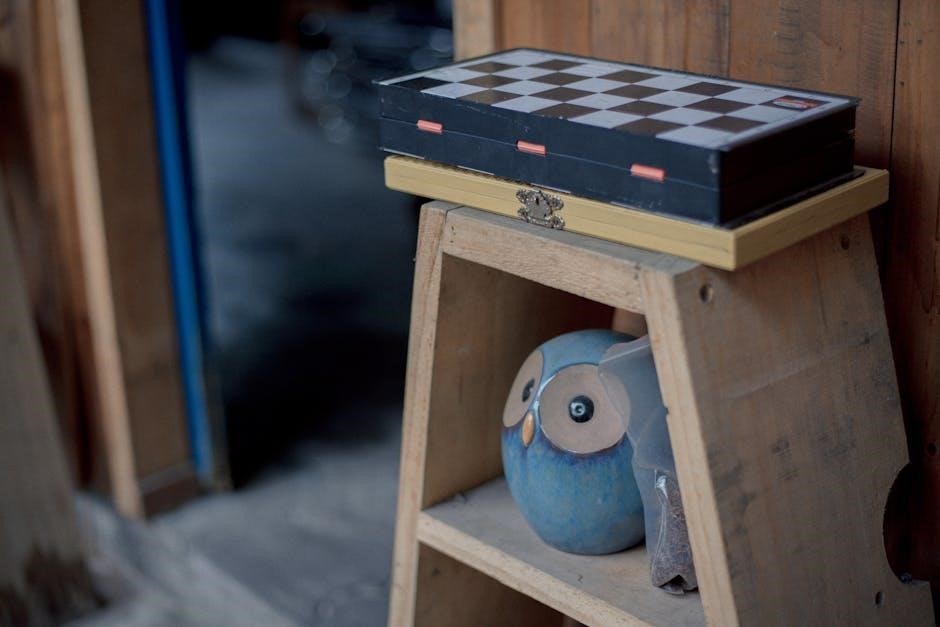Screech owl box plans provide detailed instructions for building nesting habitats, supporting conservation efforts and attracting these beneficial birds to your yard. Easy to follow, these PDF guides ensure accurate construction, helping create safe spaces for screech owls to thrive.
What are Screech Owl Boxes?
Screech owl boxes are specially designed nesting habitats for eastern screech-owls, providing them with safe spaces to roost, nest, and raise their young. These boxes are typically made of wood, with dimensions tailored to the owls’ needs, and feature a hole for entry, internal space for nesting, and ventilation for airflow. They are often equipped with a roof to protect against weather and predators. The boxes mimic natural tree cavities, which screech-owls naturally inhabit, and are essential for supporting these birds, especially in areas where natural habitats are scarce. By installing screech owl boxes, homeowners and conservationists can attract these beneficial birds, which help control insect and small rodent populations, contributing to a balanced ecosystem.
Why Build a Screech Owl Box?
Building a screech owl box is a rewarding way to support wildlife conservation and attract these beneficial birds to your property. Screech owls are natural predators of insects and small rodents, making them a valuable asset for pest control. By providing a nesting box, you create a safe habitat for these owls, which often struggle to find suitable nesting sites due to habitat loss. Additionally, screech owl boxes offer educational opportunities to learn about these fascinating birds and their importance in the ecosystem. With PDF plans readily available, constructing a box is accessible for DIY enthusiasts of all skill levels, making it a fun and meaningful project for nature lovers and families alike.
Benefits of Using PDF Plans
Using PDF plans for screech owl boxes offers numerous advantages, ensuring a successful and enjoyable DIY project. These plans provide clear, detailed instructions with precise measurements and material lists, minimizing errors and saving time. PDFs are easily accessible and printable, allowing you to refer to them anytime during construction. They often include visuals and diagrams, making complex steps easier to understand. Additionally, PDF plans are cost-effective and environmentally friendly compared to physical copies. Many plans are designed by experts, guaranteeing that the final product meets the specific needs of screech owls. This ensures the box is both functional and attractive, enhancing your backyard while supporting wildlife conservation. With PDF plans, you can confidently build a high-quality nesting box tailored to attract these beneficial birds.

Materials Needed for Screech Owl Boxes
Screech owl boxes require durable materials like untreated pine wood, wood chips for bedding, nails, screws, and waterproof roofing to ensure longevity and safety for the owls.

Wood Selection and Dimensions
For screech owl boxes, untreated pine wood is recommended due to its durability and natural resistance to rot. The dimensions typically include a floor size of 7 3/4 inches, sides measuring 14 inches, and a roof spanning 16 inches. The front and back panels are usually 12 inches and 14 inches, respectively, with a depth of 22 inches. Precise cuts, such as the 3/8-inch detail for slant cuts, ensure proper assembly. Using wood of consistent thickness, like 3/4 inch, helps maintain structural integrity. These measurements are designed to provide adequate space for the owls while ensuring the box remains compact and secure. Proper wood selection and precise dimensions are critical for creating a safe and functional habitat for screech owls.
Fasteners and Hardware Requirements
Building a screech owl box requires durable fasteners to ensure longevity. Use 1-2 inch galvanized or stainless steel screws to assemble the box, as they resist rust and withstand outdoor conditions. Hinges for the roof should be sturdy, allowing easy access for cleaning and maintenance. Add a small latch or hook to secure the roof in place. Nails can be used for additional support, but screws are preferred for their strength. Waterproof glue can be applied to seams to prevent moisture entry. Avoid using nails that protrude, as they may harm the owls. Proper hardware ensures the box remains secure, protecting the owls from predators and harsh weather. Durable fasteners are essential for creating a safe and long-lasting habitat for screech owls.
Nesting Box Bedding Material
Adding bedding material to a screech owl nesting box enhances comfort and hygiene for the birds. Wood chips or sawdust are ideal choices, as they absorb moisture and provide insulation. Avoid using straw or grass, as these can harbor pests. Fill the box with 2-3 inches of bedding material to create a soft, dry surface for nesting. This layer also helps maintain cleanliness and reduces odor. Change the bedding annually or when signs of wear are visible. Proper bedding material supports the health and well-being of the owls, encouraging them to nest and raise their young safely. Keep the material dry to prevent mold growth, ensuring a welcoming environment for screech owls throughout the year.

Tools Required for Assembly
Power tools like drills and saws are essential for cutting and drilling wood. Hand tools such as screwdrivers and hammers are needed for assembling the box. Safety equipment, including gloves and goggles, ensures protection during the process. Proper tools ensure accurate and efficient construction of the screech owl nesting box.
Power Tools for Cutting and Drilling
Power tools are indispensable for accurately cutting and drilling wood when building a screech owl box. A circular saw is ideal for making straight cuts in lumber, while a jigsaw or handheld saw works well for curved cuts. A drill press or cordless drill is essential for creating precise holes, such as the entrance hole and ventilation gaps. Sanding tools, like an orbital sander, can smooth rough edges to ensure the box is safe for the owls. These tools ensure precise measurements and a professional finish. Optional tools, like a router, can add decorative edges or weatherproofing details. Always use safety equipment, such as goggles and dust masks, when operating power tools to protect yourself during the assembly process.
Hand Tools for Assembly
Hand tools are crucial for assembling a screech owl box, ensuring precise and secure construction. A hammer is essential for tapping pieces into place and driving nails or screws. Screwdrivers, both flathead and Phillips, are needed for tightening hardware. A tape measure helps verify dimensions, while a utility knife or chisel can trim excess wood or create small notches. Pliers or a wrench may be useful for tightening bolts or wire. A rubber mallet is handy for fitting parts together without damaging the wood. Sandpaper can smooth out rough edges for safety. A level ensures the box is properly aligned during assembly. These tools allow for precise, manual adjustments, ensuring the nesting box is sturdy and well-constructed for the owls. Proper use of hand tools guarantees a safe and durable habitat for screech owls.
Safety Equipment
When assembling a screech owl box, safety equipment is essential to protect yourself from potential hazards. Safety glasses or goggles should be worn to shield your eyes from sawdust and debris during cutting and drilling. A dust mask is recommended to prevent inhaling wood particles. Gloves provide grip and protection from splinters and cuts. Hearing protection, such as earplugs, is advisable when using power tools like drills or saws. A first aid kit should be nearby in case of minor accidents. Wearing long sleeves and closed-toe shoes can prevent skin irritation and injuries. Proper safety gear ensures a safe and enjoyable building experience, allowing you to focus on creating a secure habitat for screech owls. Always follow safety guidelines and tool manufacturer recommendations to avoid accidents.

Assembly Instructions
Follow detailed PDF plans for precise assembly. Start by preparing materials, then construct the box, and finally attach the roof. Ensure all pieces fit securely for durability and safety.
Preparing the Materials
Begin by gathering all necessary materials as specified in your PDF plans. Cut the wood according to the dimensions provided, ensuring accuracy for proper assembly. Sand all edges to remove splinters and sharp points. Pre-drill holes for screws to prevent wood from splitting. Sort and label each piece, such as the floor, sides, roof, and back, to streamline the assembly process. If using bedding material like wood chips, prepare it by drying thoroughly. Double-check that all components match the plan’s requirements before proceeding. This step ensures a smooth and efficient construction process, adhering to the design specifications for a safe and durable screech owl box.

Constructing the Box
Assemble the box by attaching the floor to the sides using screws, ensuring a secure fit. Align the back panel and front piece, fastening them to the sides. Make sure the entrance hole is correctly positioned according to the plans. Use weather-resistant screws to attach the roof, allowing for easy access if needed. Add bedding material like wood chips inside the box for nesting comfort. Ensure all edges are smooth and free of splinters. Double-check the alignment and stability of each component. Follow the PDF plans carefully to maintain the box’s structural integrity. Proper construction ensures the box provides a safe and cozy habitat for screech owls, promoting successful nesting and roosting. Attention to detail is key for a durable and functional nesting box.
Attaching the Roof
Align the roof with the top edges of the box, ensuring proper fit and alignment. Secure it using weather-resistant screws or hinges for easy access. If using hinges, attach them to the back of the box for a liftable roof design. Tighten screws firmly to prevent gaps or movement. For a fixed roof, apply a small amount of waterproof sealant around the edges to ensure durability. Ensure the roof is slightly angled to allow water runoff. Avoid over-tightening, as this may damage the wood. Double-check the roof’s stability and alignment before finalizing. Properly attaching the roof ensures the box remains weatherproof and secure, providing a safe environment for screech owls. Follow the PDF plans for specific measurements and techniques to achieve a professional finish.
Placement and Installation
Install screech owl boxes at least 10 feet above ground, facing east to southeast, to provide optimal shelter. Use metal poles if squirrels are a concern to prevent damage.
Choosing the Right Location
Selecting the right spot for your screech owl box is crucial for attracting these birds. Ideal locations include open areas near woodlands or wetlands, as screech owls prefer edges for hunting. Avoid densely forested regions, as they favor open or semi-open habitats. Ensure the box is placed in an area with minimal human disturbance to encourage owl activity. Facing the box east or southeast can help regulate internal temperature, protecting the owls from harsh weather. Additionally, installing multiple boxes with varying hole orientations can attract different species, enhancing biodiversity. Proper placement increases the likelihood of occupancy and supports local wildlife conservation efforts effectively.
Installation Height and Orientation
Installing your screech owl box at the correct height and orientation is essential for its success. Boxes should be placed at least 10 feet above the ground to protect the owls from predators and ensure easy access for hunting. For optimal results, position the box in an area with an open flight path, avoiding branches that could obstruct the owls’ movement. The box should face east or southeast to provide shade during the hottest parts of the day and protect against harsh weather conditions. Proper orientation also helps regulate the internal temperature, creating a comfortable environment for the owls. Ensure the box is securely mounted to a sturdy tree or pole, using methods like lag bolts or wire for stability. This setup encourages occupancy and supports the well-being of the screech owls.
Mounting Techniques
Mounting your screech owl box securely is crucial for its stability and effectiveness. Use lag bolts or screws to attach the box to a sturdy tree or pole, ensuring it remains level and firmly in place. For areas with squirrel activity, consider mounting the box on a metal pole, as squirrels cannot climb smooth surfaces. Avoid using nails, as they may not provide sufficient stability over time. If using a tree, choose one with a wide trunk to support the weight of the box and any potential occupants. Tighten all fasteners properly to prevent the box from swaying in the wind. Mounting at the recommended height and orientation ensures the box remains safe and accessible for the owls. Proper mounting techniques also help protect the box from harsh weather conditions and predators, ensuring long-term durability and effectiveness.

Maintenance and Care

Regular maintenance ensures the longevity and effectiveness of screech owl boxes. Clean the box annually, removing debris and soiled bedding. Inspect for damage and repair as needed. Monitor for pests like insects or mice, addressing issues promptly to maintain a safe environment for the owls.
Cleaning the Nesting Box
Cleaning the nesting box is essential for maintaining a healthy environment for screech owls. Remove all bedding material and debris annually, preferably during the winter when the box is inactive. Use gloves and a mild detergent to scrub the interior, ensuring no harmful residues remain. Rinse thoroughly and allow the box to dry completely before reinstalling fresh bedding like wood chips. Avoid using chemicals or harsh cleaners, as they can deter owls or harm them. Regular cleaning prevents the buildup of parasites and bacteria, ensuring the box remains a safe and inviting space for screech owls to nest and raise their young.

Repairing Damages
Regular inspections and timely repairs are crucial to ensure the nesting box remains safe and functional for screech owls. Check for holes, cracks, or loose boards, which can admit predators or weather. Use waterproof glue or wood filler to seal gaps, and replace any severely damaged sections. If the roof is loose, reattach it securely to prevent leaks. Avoid using nails that protrude inside, as they can harm the owls. For predator damage, such as squirrel chew marks, reinforce the wood or add a metal guard around the entrance hole. Ensure all repairs are made with non-toxic materials to protect the birds. Regular maintenance helps extend the box’s lifespan and provides a secure habitat for screech owls.
Monitoring for Pests
Monitoring for pests is essential to maintain a safe and healthy environment for screech owls. Regularly inspect the nesting box for signs of infestation, such as droppings, gnaw marks, or nesting material disruption. Common pests include squirrels, mice, and insects, which can compete with owls for the box or cause damage. Check for holes or gaps that may allow predators to enter. If pests are present, consider installing a metal guard around the entrance hole to deter squirrels or using non-toxic repellents. Keep the surrounding area clean to avoid attracting pests. Monitoring ensures the box remains a secure habitat for screech owls and prevents potential threats to their nesting success. Regular checks also help identify issues early, allowing for timely interventions to protect both the owls and the nesting box.
Benefits of Screech Owl Boxes
Screech owl boxes attract these beneficial birds, enhancing biodiversity and natural pest control. They provide nesting sites, supporting owl populations and offering educational opportunities to learn about wildlife conservation.
Environmental Impact
Screech owl boxes contribute positively to the environment by providing habitats for these birds, which help control insect and small rodent populations. This natural form of pest control reduces the need for pesticides, promoting a healthier ecosystem. Additionally, by supporting screech owl populations, these boxes aid in maintaining biodiversity, which is crucial for ecological balance. They also raise awareness about wildlife conservation, encouraging sustainable practices and community involvement in environmental stewardship. Overall, screech owl boxes are a simple yet effective way to make a positive impact on local wildlife and the environment.
Wildlife Conservation
Screech owl boxes play a vital role in wildlife conservation by providing essential nesting and roosting habitats for these birds. As natural predators, screech owls help control populations of insects and small rodents, reducing the need for pesticides and maintaining ecological balance. By installing these boxes, individuals contribute to the preservation of screech owl populations, which are often threatened by habitat loss. Additionally, screech owl boxes support biodiversity by offering a safe space for these birds to breed and raise their young. Conservation efforts are further enhanced as these boxes encourage the study and monitoring of screech owl behavior, aiding in broader wildlife protection initiatives. This simple yet effective method fosters a connection between humans and wildlife, promoting coexistence and environmental stewardship.
Educational Opportunities
Educational Opportunities
Building screech owl boxes offers a hands-on learning experience, teaching individuals about wildlife conservation and the importance of providing habitats for birds. These projects serve as excellent educational tools for schools, scout groups, and community organizations, fostering an appreciation for nature. Participants learn about the life cycle of screech owls, their nesting habits, and the role these birds play in controlling insect and rodent populations. Workshops and guides often accompany screech owl box plans, making it easier for educators to incorporate these activities into curricula. By involving people in the construction and installation process, screech owl box projects inspire stewardship and promote environmental awareness. This engagement not only educates but also encourages future generations to take an active role in wildlife conservation efforts.
Troubleshooting Common Issues
Predators, competing species, and maintenance problems can arise. Use metal poles to deter climbers, install multiple boxes to reduce competition, and regularly clean and repair boxes.
Predator Prevention
To protect screech owls from predators, install nesting boxes on metal poles, as this deters climbers like raccoons and snakes. Use baffles or predator guards around the pole to prevent access. Ensure the box is at least 10 feet above ground to reduce predator reach. Avoid placing boxes near trees with branches that predators can use to jump onto the box. Regularly inspect the box for signs of predator damage and repair promptly. Using smooth materials like metal or PVC for the pole can also discourage climbing predators. These measures help safeguard the owls and ensure the nesting box remains a safe habitat for them. Proper placement and additional protective features are essential for effective predator prevention.
Dealing with Competing Species
Screech owl boxes can attract competing species like European Starlings, which may displace the owls. To minimize competition, mount multiple boxes with varying hole sizes and orientations to cater to different species. Place boxes in open areas, as screech owls prefer these locations, while starlings often favor wooded spots. Regularly monitor the boxes to ensure they are being used by the intended species. If starlings are a persistent issue, consider installing a roof or modifying the entrance hole to deter them. Providing alternative nesting sites nearby can also help reduce competition. By taking these steps, you can create a balanced environment that supports screech owls while managing competing species effectively. This approach ensures the nesting boxes remain a valuable resource for the owls.
Addressing Maintenance Problems
Maintenance is crucial to ensure the longevity and effectiveness of screech owl boxes. Regularly inspect the box for damage, such as rotting wood or holes, and repair or replace worn parts promptly. Cleaning the box annually, especially after nesting season, helps remove debris and parasites. Use a mild detergent and rinse thoroughly to avoid harming the owls. Monitoring for pests like insects or rodents is essential, as they can deter screech owls from using the box. Consider using non-toxic repellents or sealing entry points to prevent infestations. Addressing these issues ensures the box remains a safe and welcoming habitat for screech owls, supporting their presence in your area.
Conclusion
Building screech owl boxes is a rewarding project that supports wildlife conservation and enhances your backyard ecosystem. With proper planning and care, these boxes provide vital habitats for screech owls, promoting their presence and benefiting the environment. By following detailed PDF plans, you can create a safe and welcoming space for these birds, contributing to their survival and enjoyment for years to come.
Summary of Key Points
Screech owl box plans provide essential guidance for creating habitats that attract these birds. Key elements include proper box dimensions, hole sizes, and mounting heights. Placement in suitable locations, such as near trees or open areas, is crucial for occupancy. Materials like untreated wood and wood chips are recommended for safety and comfort. Regular maintenance, including cleaning and repairs, ensures the box remains functional. Following PDF plans helps ensure the box meets the specific needs of screech owls, supporting their conservation. By building and maintaining these boxes, you contribute to wildlife preservation and create opportunities to observe these fascinating birds. Proper installation and care are vital for the success of the nesting box and the well-being of the owls it hosts.
Encouragement to Build
Building a screech owl box is a rewarding project that supports wildlife conservation and enhances your outdoor space. By providing a safe habitat, you help these birds thrive and contribute to their population. Owls are natural predators of pests, making them beneficial for your garden and ecosystem. The process is fun and educational, offering a chance to learn about these fascinating birds. With PDF plans, you can easily follow step-by-step instructions, ensuring a successful build. Whether you’re a seasoned DIYer or a beginner, this project is achievable and impactful. Take the opportunity to make a difference for screech owls and enjoy the joy of observing them in their natural habitat. Start building today and become a part of their conservation story!

Final Thoughts
Building a screech owl box is a simple yet meaningful way to support wildlife conservation and enjoy the beauty of nature. By following PDF plans, you can create a safe habitat for these birds, helping them thrive in your area. Screech owls play a vital role in controlling pest populations, making them a welcome addition to any backyard. The process of building and installing a nesting box is not only rewarding but also educational, offering insights into the lives of these fascinating birds. Whether you’re a nature enthusiast or a DIY hobbyist, this project is a great way to give back to the environment. Take pride in knowing you’re contributing to the conservation of screech owls and enjoy the unique opportunity to observe them up close. Your efforts can make a lasting difference for these incredible creatures.
